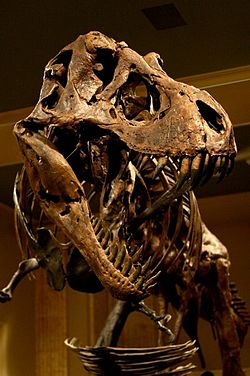Cretaceous
Period in the Mesozoic Era
The Cretaceous Period is a geological period that lasted from about 145 to 66 million years ago. It is the third and final period of the Mesozoic Era, following the Jurassic Period and preceding the Paleogene Period of the Cenozoic Era. The Cretaceous is notable for being the longest period of the Phanerozoic Eon, lasting approximately 79 million years.
Geological Characteristics[edit]
The Cretaceous Period is characterized by high sea levels and the development of extensive shallow inland seas. These seas were home to a diverse array of marine life, including ammonites, belemnites, and rudists. The period also saw the breakup of the supercontinent Pangaea, leading to the formation of the modern continents.
Tectonics[edit]
During the Cretaceous, the movement of tectonic plates was significant. The Atlantic Ocean continued to widen as North America and Eurasia drifted apart. The Indian Plate began its northward journey towards the Asian Plate, which would eventually lead to the formation of the Himalayas in the Cenozoic Era.
Climate[edit]
The climate of the Cretaceous was generally warm, with little to no polar ice. This warm climate supported lush vegetation and a wide variety of dinosaur species. The high levels of carbon dioxide in the atmosphere contributed to the greenhouse conditions of the period.
Flora and Fauna[edit]
The Cretaceous Period was a time of significant evolutionary change. It saw the rise of angiosperms (flowering plants), which began to dominate the landscape. These plants provided new food sources for herbivorous dinosaurs and other animals.
Dinosaurs[edit]

The Cretaceous is perhaps best known for its diverse and abundant dinosaur fauna. Iconic dinosaurs such as Tyrannosaurus rex, Triceratops, and Velociraptor roamed the Earth during this time. The period also saw the evolution of birds from small theropod dinosaurs.
Marine Life[edit]

The Cretaceous seas were teeming with life, including large marine reptiles like mosasaurs, plesiosaurs, and ichthyosaurs. Invertebrates such as ammonites and belemnites were also abundant.
Extinction Event[edit]
The Cretaceous Period ended with one of the most significant mass extinctions in Earth's history, known as the Cretaceous–Paleogene extinction event. This event led to the extinction of approximately 75% of Earth's species, including all non-avian dinosaurs. The leading hypothesis for this extinction is the impact of a large asteroid or comet in the region of present-day Chicxulub in Mexico.
Related Pages[edit]
Ad. Transform your life with W8MD's Budget GLP-1 injections from $75


W8MD offers a medical weight loss program to lose weight in Philadelphia. Our physician-supervised medical weight loss provides:
- Weight loss injections in NYC (generic and brand names):
- Zepbound / Mounjaro, Wegovy / Ozempic, Saxenda
- Most insurances accepted or discounted self-pay rates. We will obtain insurance prior authorizations if needed.
- Generic GLP1 weight loss injections from $75 for the starting dose.
- Also offer prescription weight loss medications including Phentermine, Qsymia, Diethylpropion, Contrave etc.
NYC weight loss doctor appointmentsNYC weight loss doctor appointments
Start your NYC weight loss journey today at our NYC medical weight loss and Philadelphia medical weight loss clinics.
- Call 718-946-5500 to lose weight in NYC or for medical weight loss in Philadelphia 215-676-2334.
- Tags:NYC medical weight loss, Philadelphia lose weight Zepbound NYC, Budget GLP1 weight loss injections, Wegovy Philadelphia, Wegovy NYC, Philadelphia medical weight loss, Brookly weight loss and Wegovy NYC
|
WikiMD's Wellness Encyclopedia |
| Let Food Be Thy Medicine Medicine Thy Food - Hippocrates |
Medical Disclaimer: WikiMD is not a substitute for professional medical advice. The information on WikiMD is provided as an information resource only, may be incorrect, outdated or misleading, and is not to be used or relied on for any diagnostic or treatment purposes. Please consult your health care provider before making any healthcare decisions or for guidance about a specific medical condition. WikiMD expressly disclaims responsibility, and shall have no liability, for any damages, loss, injury, or liability whatsoever suffered as a result of your reliance on the information contained in this site. By visiting this site you agree to the foregoing terms and conditions, which may from time to time be changed or supplemented by WikiMD. If you do not agree to the foregoing terms and conditions, you should not enter or use this site. See full disclaimer.
Credits:Most images are courtesy of Wikimedia commons, and templates, categories Wikipedia, licensed under CC BY SA or similar.
Translate this page: - East Asian
中文,
日本,
한국어,
South Asian
हिन्दी,
தமிழ்,
తెలుగు,
Urdu,
ಕನ್ನಡ,
Southeast Asian
Indonesian,
Vietnamese,
Thai,
မြန်မာဘာသာ,
বাংলা
European
español,
Deutsch,
français,
Greek,
português do Brasil,
polski,
română,
русский,
Nederlands,
norsk,
svenska,
suomi,
Italian
Middle Eastern & African
عربى,
Turkish,
Persian,
Hebrew,
Afrikaans,
isiZulu,
Kiswahili,
Other
Bulgarian,
Hungarian,
Czech,
Swedish,
മലയാളം,
मराठी,
ਪੰਜਾਬੀ,
ગુજરાતી,
Portuguese,
Ukrainian